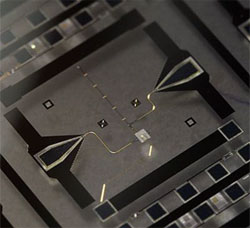University of California, Santa Barbara (UCSB) researchers have made a major breakthrough in experimental quantum mechanics.
UCSB physicists Max Hofheinz, John Martinis and Andrew Cleland have documented how they used a superconducting electronic circuit known as a Josephson phase qubit, developed in Martinis's lab, to controllably pump microwave photons, one at a time, into a superconducting microwave resonator.
A close-up of one of the circuits used in the quantum mechanics experiment. (Photo courtesy UCSB)
Up to six photons were pumped into and stored in the resonator, and their presence was then detected using the qubit, which acts like an electronic atom, as an analyzer. The photon number states, known as Fock states, have never before been controllably created, said Cleland.
"These states are ones you learn about in introductory quantum mechanics classes, but no one has been able to controllably create them before," Cleland said.
Using the same technique, the researchers also created another type of special state, known as a coherent state, in the superconducting resonator. These states are relatively easily generated, and appear to behave in a completely non-quantum mechanical fashion, but by using the same analysis technique, the UCSB researchers were able to demonstrate the expected underlying quantum behavior.
Hofheinz, a postdoctoral researcher from Germany who's been at UCSB for the past year working on this project, explained how the resonator works.
"The resonator is the electrical equivalent of a pendulum," Hofheinz said. "In quantum mechanics the energy, or amplitude of motion of this pendulum, only comes in finite steps, in quanta. We first carefully prepared the resonator in these quantum states, and showed we could do this controllably and then measure the states. Then we 'kicked' the pendulum directly, a method where the amplitude can take on any value, and appears to not be limited to these quanta. But when we look at the resonator with our qubit, we see that the amplitude does come in steps, but that the resonator is actually in several such states at the same time, so that on average it looks like it is not limited to the quantum states."
Hofheinz spent several months in the UCSB Nanofabrication cleanroom fabricating the device used for the experiment.
"This resonator, once you excite it, has to 'swing' for a very long time," he explained. "The first samples I fabricated stopped oscillating very quickly. We had to work to rearrange the fabrication method to get the resonator to oscillate longer."
He then fine-tuned the microwave electronics built by Martinis's group to emit the precisely shaped signals necessary to produce these exciting results.
Martinis, Cleland and Hofheinz say that their research could help in the quest to build a possible quantum computer, which both the government and industry have been seeking for a long time. A quantum computer could be used to break – or make – the encryption codes most heavily used for secure communication.
"Harmonic oscillators might allow us to get a quantum computer built more quickly," Cleland said.
"I think if they really build one of these quantum computers, there will definitely be resonators in them," Hofheinz said.
For more information, visit: www.ucsb.edu